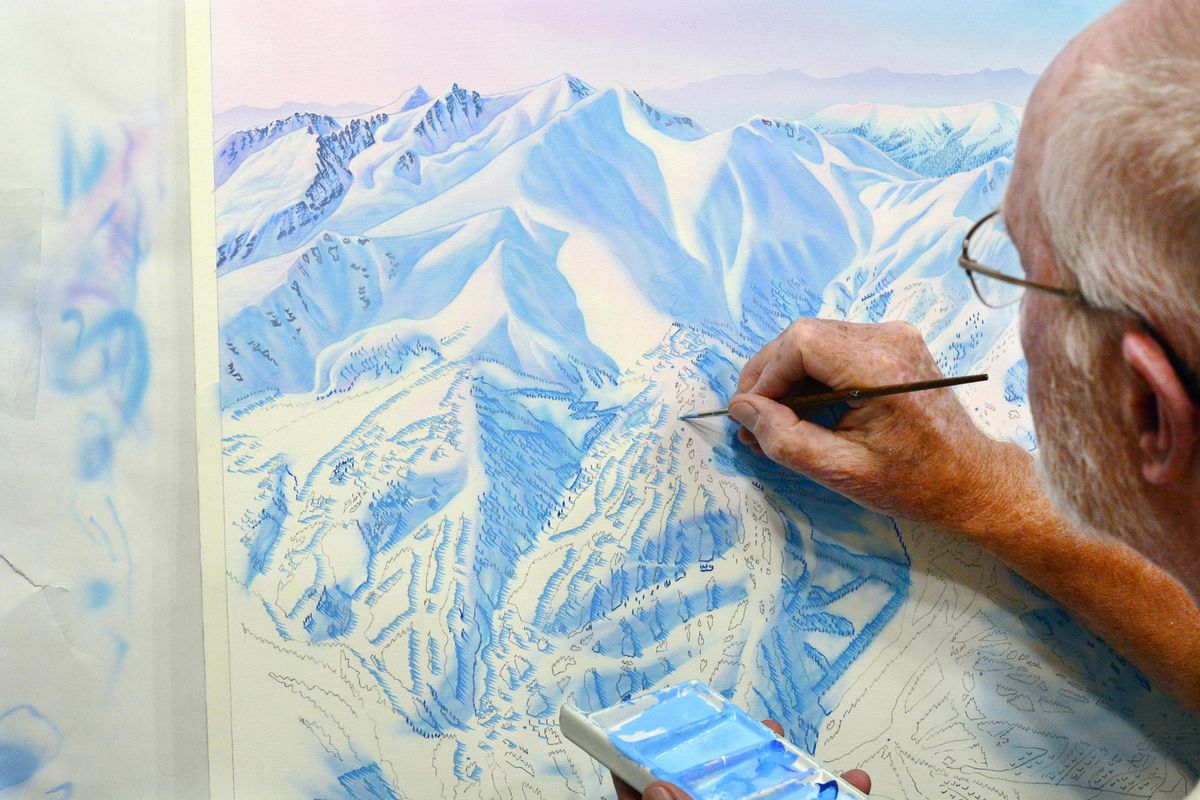Mapping the brilliant career of ‘the Michelangelo of snow’

When skiers dismount the Swift Current chairlift at Montana’s Big Sky resort, they encounter – lodged deep into the snow – a placard bearing a panoramic view of Lone Peak from the mind’s eye of James Niehues.
His pristine, hand-painted images have served as a guide to the steeps, couloirs and cliffs for skiers during the past three decades. For his airy and intricately detailed landscapes depicting mountain resorts, the prolific watercolorist has earned acclaim but not broad recognition beyond attentive skiers who happen to notice his signature camouflaged in the pines and spruces of his pictures.
In fact, the work of the artist regarded as “the Michelangelo of snow” is so ubiquitous on ski mountains across North America that most of the major resorts’ maps feature his illustrations: Whistler-Blackcomb, Vail, Park City, Sun Valley, Taos – among 160 more. Niehues’s maps have woven the artist deeply into the fabric of ski culture.
“His trail maps are as much a part of the sport as snow,” Greg Ditrinco, executive editor of Ski magazine, told the Associated Press in 2011.
Niehues – describing himself modestly as an intermediate skier who prefers corduroy groomers – did not begin his career as a map illustrator until he was in his 40s. But he had long felt a passion for painting landscape scenes reminiscent of the Colorado mountain vistas that surrounded him in his youth. Niehues, 70, grew up in Loma, in Mesa County, Colorado, on a farm where his father grew alfalfa, corn and potatoes, and raised cattle and hogs.
“I remember very well because it was my job every weekend to scoop all the manure into the manure spreader and get it out into the fields,” Niehues said. “It was a very dirty job.”
He came by his interest in the outdoors honestly, accompanying his father on autumn deer-hunting trips down the Colorado River by boat. But as a teenager, he was bedridden for two months with a bout of nephritis and spent the time on his back painting scenery from a mail-order kit given to him by his mother.
“I would find a photograph in a magazine somewhere and paint that,” Niehues said of his introductory artistic training.
He joined the Army in 1965 and served in Berlin, where he took a trip to the Alps in Switzerland and skied for the first time. Upon returning home, he visited Powderhorn Mountain Resort, but learned that his skills didn’t translate to the Rocky Mountains.
“I ended up walking off the slopes,” Niehues said.
His military service ended in 1969, and Niehues worked as a pressman, a graphic designer and as partner at an advertising agency before turning full time to illustrations in 1988. His first job was painting a portion of the Winter Park Resort in Colorado. Since then, he has used gouache to paint a total of more than 220 ski maps.
His artwork is renowned for its detail. He paints every tree by hand, and it can be painstaking work.
For a time he became so in demand that he got a bad case of tennis elbow and had to use a sling.
When he is commissioned to paint a mountain, he flies in a small plane to take aerial photographs that he later uses for reference. Niehues then forms a composite of the terrain and uses light and shading to emphasize points of interest for skiers.
Occasionally, he’ll even ski the mountain to get a better feel for its features, but he admits that he has tried only about 5 percent of the resorts he has painted.
For instance, Niehues said that he’s in the process of completing a map of Breckenridge, an expansive resort in Colorado, despite never having set foot on its peaks.
Greg Ralph, marketing director for the Monarch Mountain resort, told the Colorado Springs Gazette in 2007 that when it came time for a new ski map there was only one choice.
“We never thought of anyone else,” Ralph said. “I mean, it’s like hearing Michelangelo is available to paint the ceiling. You say, ‘Cool, we’ll take him.’”
The result often is a faithful rendition of a mountain’s natural splendor, with its sharp edges, gentle folds and layered bedrock.
New York Times art critic Ken Johnson once described Niehues’s work in 2006 as having “a slightly primitive lucidity that calls to mind early American folk art.”
Niehues said that he likes knowing that skiers take a piece of him in their pockets whenever they ski the mountains he has painted.
“One of the more special things is that they come down the mountain and have a beer and open up the map and talk about their experiences and they’re reviewing my art,” Niehues said.
Niehues is mostly retired and recently returned home to Loveland, Colorado, from a month-long road trip to the East Coast, where he visited Niagara Falls and upstate New York. He has an archive of thousands of photographs from years past of scenes he one day would like to paint.
“Every scene has something special about it,” he said.
During the trip, he stopped to take a picture of an Amish country barn, where the corn was being harvested by a horse-drawn wagon. His wife took a particular liking to it.
“Whether I’ll ever paint it or not I never know,” Niehues said. Then, after a brief pause, “But I think I better paint it.”